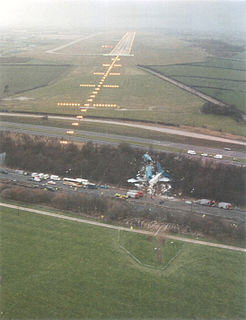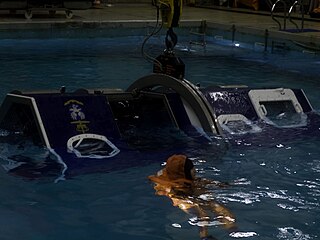
An aviation accident is defined by the Convention on International Civil Aviation Annex 13 as an occurrence associated with the operation of an aircraft, which takes place from the time any person boards the aircraft with the intention of flight until all such persons have disembarked, and in which a) a person is fatally or seriously injured, b) the aircraft sustains significant damage or structural failure, or c) the aircraft goes missing or becomes completely inaccessible. Annex 13 defines an aviation incident as an occurrence, other than an accident, associated with the operation of an aircraft that affects or could affect the safety of operation.

A flight attendant, also known as steward/stewardess or air host/air hostess, is a member of the aircrew aboard commercial flights, many business jets and some government aircraft. Collectively called cabin crew, flight attendants are primarily responsible for passenger safety and comfort.

The Kegworth air disaster occurred when British Midland Airways Flight 092, a Boeing 737-400, crashed onto the motorway embankment between the M1 motorway and A453 road near Kegworth, Leicestershire, England, while attempting to make an emergency landing at East Midlands Airport on 8 January 1989.

Aviation safety is the study and practice of managing risks in aviation. This includes preventing aviation accidents and incidents through research, educating air travel personnel, passengers and the general public, as well as the design of aircraft and aviation infrastructure. The aviation industry is subject to significant regulation and oversight.

Saudia Flight 163 was a scheduled Saudia passenger flight that caught fire after takeoff from Riyadh International Airport en route to Jeddah, Saudi Arabia on 19 August 1980. All 287 passengers and 14 crew on board the Lockheed L-1011-200 TriStar died from smoke inhalation after the aircraft made a successful emergency landing at Riyadh.

British Airtours Flight 28M was an international passenger flight which caught fire before takeoff at Manchester Airport, England on 22 August 1985 with the loss of 55 lives. It was en route to Corfu International Airport in Greece.
To assume a brace position or crash position is an instruction that can be given to prepare for a crash, such as on an aircraft; the instruction to "Brace for impact!" or "Brace! Brace!" is often given if the aircraft must make an emergency landing on land or water. There are many different ways to adopt the brace position, with many countries adopting their own version based on research performed by their own aviation authority or that of other countries. The most common in passenger airliners being the forward-facing seat version, in which the person bracing places their head against or as close as possible to the surface it is likely to strike, placing their feet firmly on the floor, and their hands either on their head or the seat in front.

An emergency exit in a structure is a special exit for emergencies such as a fire: the combined use of regular and special exits allows for faster evacuation, while it also provides an alternative if the route to the regular exit is blocked.

Air France Flight 358 was a regularly scheduled international flight from Charles de Gaulle Airport in Paris, France, to Toronto Pearson International Airport in Ontario, Canada. On the afternoon of 2 August 2005, while landing at Pearson Airport, the Airbus A340-313E operating the route overran the runway and crashed into nearby Etobicoke Creek, approximately 300 m (980 ft) beyond the end of the runway. All 309 passengers and crew on board the Airbus survived, but twelve people sustained serious injuries. The accident highlighted the vital role played by highly trained flight attendants during an emergency.

A chicken gun or flight impact simulator is a large-diameter, compressed-air gun used to fire bird carcasses at aircraft components in order to simulate high-speed bird strikes during the aircraft's flight. Jet engines and aircraft windshields are particularly vulnerable to damage from such strikes, and are the most common target in such tests. Although various species of bird are used in aircraft testing and certification, the device acquired the common name of "chicken gun" as chickens are the most commonly used 'ammunition' owing to their ready availability.

Aircraft rescue and firefighting (ARFF) is a type of firefighting that involves the emergency response, mitigation, evacuation, and rescue of passengers and crew of aircraft involved in aviation accidents and incidents.

A pre-flight safety briefing is a detailed explanation given before take-off to airline passengers about the safety features of the aircraft they are aboard.

An evacuation slide is an inflatable slide used to evacuate an aircraft quickly. An escape slide is required on all commercial aircraft where the door sill height is such that, in the event of an evacuation, passengers would be unable to step down from the door uninjured.

An airline seat is a seat on an airliner in which passengers are accommodated for the duration of the journey. Such seats are usually arranged in rows running across the airplane's fuselage. A diagram of such seats in an aircraft is called an aircraft seat map.

Overwing exits are found on passenger aircraft to provide a means of evacuation onto the wing, where passengers continue off the trailing edge, either by sliding down the extended flaps or by using an evacuation slide that deploys when the exit is opened.

Helicopter Underwater Escape Training ; often abbreviated as HUET, pronounced hue-wet, hue-way or you-way) is training provided to helicopter flight crews, offshore oil and gas industry, law enforcement personnel, and military personnel who are regularly transported by helicopters over water. As the name implies, the purpose of this training is to prepare passengers and crew for an emergency evacuation or egress in the event of a crash landing on water.
Aerotoxic syndrome relates to ill-health effects that are claimed to be caused by breathing contaminated airliner cabin air. This condition is not an established medical diagnosis.

Civil Aerospace Medical Institute (CAMI) is the medical certification, education, research, and occupational medicine wing of the Office of Aerospace Medicine (AAM) under the auspices of the Federal Aviation Administration Office of Aviation Safety. The Institute's primary goal is to enhance aviation safety.
The International Board for Research into Aircraft Crash Events (IBRACE) was founded on 21 November 2016 by a group of subject-matter experts in aviation, engineering, clinical medicine, and human factors. These experts are associated with organizations that include the Civil Aerospace Medical Institute, USA (CAMI); Cranfield University, England; GRM Consulting Ltd., England; Spire Liverpool Hospital, England; TÜV Rheinland, Germany; the University of Calgary, Canada; the University of Nottingham, England; and Wonkwang University, Korea.
Susan Michaelis is a former Australian flight instructor and airline transport (ATPL) pilot. She is also a researcher working on the issue of contaminated air on aircraft and the health effects of exposure to heated jet engine oils and hydraulic fluids known to contaminate the breathing air supply on aircraft, often called Aerotoxic Syndrome. She is a part of the University of Stirling’s Occupational and Environmental Health Research group where she is a Honorary Sensor Research Fellow.














